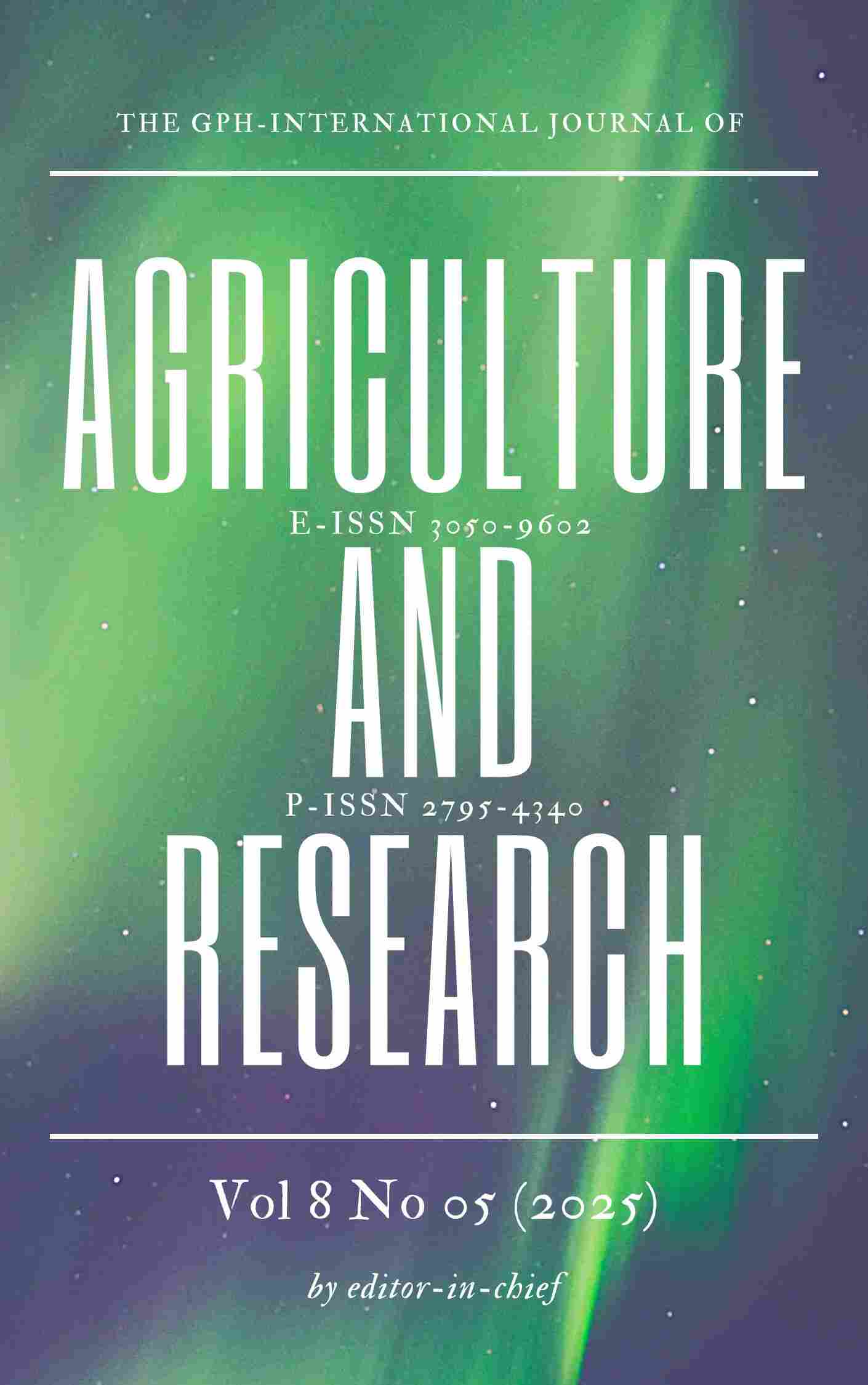ANALYSIS OF CONTRIBUTION OF CREDIT FACILITITIES TO SMALL- SCALE COCOYAM (Xanthosomasagittifolium (i) schott) PRODUCTION IN IGALAMELA ODOLU LOCAL GOVERNMENT AREA OF KOGI STATE, NIGERIA
Abstract
This study analyzed the contribution of credit facilities to small-scale cocoyam (Xanthosomasagittifolium (I) Schott) production in IgalamelaOdolu Local Government Area of Kogi State, Nigeria. A multiple-stage sampling technique was employed for the study. A total number of one hundred and twenty (120) were selected for this study. Data collected were analyzed using simple descriptive statistics, Gross margin and return per naira invested analysis as well as profitability indices. The finding of the research show that the mean age is (43.4) which show they are in their productive age, (77.5%) were male and majority (50.8%) has secondary education and the cocoyam farmer has a mean of (8.7years) of farming experience in cocoyam production. The cost and return analysis and profitability indices were pointer indicating that cocoyam is profitable (for every one naira invested in cocoyam production, (29) kobo we be return indicating moderate profitability) with a Gross margin (N 1,010,348 per farmer). The result of multiple regression analysis identifies seed cost and fertilizer cost to be positively significant at (1%) respectively while cost of herbicide is negatively significant at (1%), Ridges which is negatively significant at (5%) as well cost of storage negatively significant at (10%). And the table above shows a strong modern fit coefficient of multiple determination (R2) of (96.82%), adjusted (R2) of (96.43%). however, significant constraints include high cost of mechanization, poor road networks, and limited access to extension services. Recommendations includes, Stakeholders and Government intervention to provide input such as herbicides to farmers to aid production of cocoyam and to provide a conducive storage environment for the produce for all ward marketing.
Downloads
References
Abah, D., Ochoche, O. C., &Umakwu, J. M. (2020). Land use pattern and productivity among smallholder farmers in Kogi State: A case study of Igalamela/Odolu Local Government Areas. PAT, 16(2), 46–58.
Abiri, R., Rizan, N., Balasundram, S. K., Shahbazi, A. B., & Abdul-Hamid, H. (2023).Application of digital technologies for ensuring agricultural productivity.Heliyon, 9(12), e17083.
Adams, D. W. (2021). Are the arguments for cheap agricultural credit sound? In Undermining rural development with cheap credit (pp. 65–77). Routledge.
Adeniyi, A. G., Ighalo, J. O., &Adeyanju, C. A. (2021).Materials-to-product potentials for sustainable development in Nigeria.International Journal of Sustainable Engineering, 14(4), 664–671.
Adiele, J. G. (2023). Improving the productivity of cocoyam for food security: A review.CENTENNIAL, 256.
Adewumi, A. (2021). Analysis of farm enterprise combinations under risk and limited resource conditions among smallholder farmers in Kwara State, Nigeria (Doctoral dissertation).
Goyal, K., & Kumar, S. (2021). Financial literacy: A systematic review and bibliometric analysis. International Journal of Consumer Studies, 45(1), 80–105.
Hartmann, M., & Six, J. (2023).Soil structure and microbiome functions in agroecosystems.Nature Reviews Earth & Environment, 4(1), 4–18.
Jabbouri, I., &Farooq, O. (2021). Inadequately educated workforce and financing obstacles: International evidence from SMEs in developing countries. International Journal of Managerial Finance, 17(1), 118–137.
Jikah, A. N., & Edo, G. I. (2023).Moringaoleifera: A valuable insight into recent advances in medicinal uses and pharmacological activities. Journal of the Science of Food and Agriculture, 103(15), 7343–7361.
Kadian, S. S., Sarao, L. K., & Mohan, C. (2022). Utilization of food industry wastes. In Food processing waste and utilization (pp. 1–21).CRC Press.
Kambali, U., &Panakaje, N. (2022).A review on access to agriculture finance by farmers and its impact on their income. Available at SSRN: https://ssrn.com/abstract=4104741
Kipkogei, S., Han, J., Mwalupaso, G., Tanui, J., &Brenya, R. (2025).The synergistic effects of microcredit access and agricultural technology adoption on maize farmer’s income in Kenya.PLOS ONE, 20(1), e0316014.
Maryono, M., Killoes, A. M., Adhikari, R., & Aziz, A. A. (2024). Agriculture development through multi-stakeholder partnerships in developing countries: A systematic literature review. Agricultural Systems, 213, 103792.
Nagar, C. K. (2023). Studies on the preparation of starch from taro (Colocasiaesculenta) and its value addition (Doctoral dissertation, OUAT, Bhubaneswar).
Nzeh, E. C., &Anionwo, O. C. (2023). Cocoyam marketing in Nigerian economy: Issues and challenges. Nigerian Agricultural Policy Research Journal (NAPReJ), 10(1), 231–245.
NWAFOR, E. (2023). Adoption of recommended cocoyam production technologies among farmers in Enugu State, Nigeria (Doctoral dissertation).
Otekunrin, O. A., Sawicka, B., Adeyonu, A. G., Otekunrin, O. A., &Rachoń, L. (2021).Cocoyam [Colocasiaesculenta (L.) Schott]: Exploring the production, health and trade potentials in Sub-Saharan Africa. Sustainability, 13(8), 4483.
Author(s) and co-author(s) jointly and severally represent and warrant that the Article is original with the author(s) and does not infringe any copyright or violate any other right of any third parties, and that the Article has not been published elsewhere. Author(s) agree to the terms that the GPH Journal will have the full right to remove the published article on any misconduct found in the published article.

























